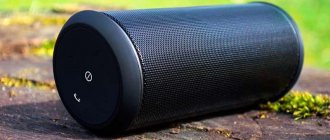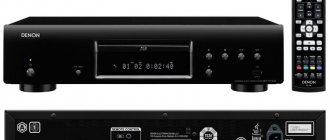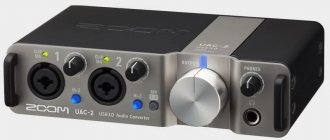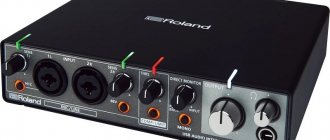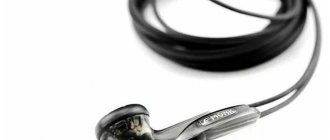How to choose a HI-FI device
The human ear perceives live sound with a wide number of shades. Audio recordings do not convey phonemes, so live music is digitized, recorded on electronic media and released in print. Next, the reverse process occurs: electronic sound is converted to analog. The process is aided by the main component, the DAC (digital-to-analog converter), and an additional component, the amplifier. To convey the depth of detail, powerful spare parts are installed in the player, with large batteries and high energy consumption.
Criteria for choosing a quality player:
- power and DAC model;
- amplifier type;
- reproducible frequency range;
- audio file formats that the gadget supports;
- operating time outside standby mode;
- connectors;
- amount of built-in memory;
- the likelihood of its expansion;
- management method;
- device weight;
- additional functions.
DAC - amplifier
The cost of the device and the quality of the music directly depend on the model and power of the DAC and amplifier. Global manufacturers produce products with specific tones: some focus on bass, others capture mids and highs. To give preference to the player, you need to listen to your favorite music. The ideal sound will appear if the device has 2 DACs.
Frequencies
Sound quality depends on the width of the reproduced frequency ranges. The maximum frequency range in the player ranges from 20 to 60 kHz. Devices of different price categories and quality operate in the range of 20 – 20,000 Hz.
File formats
There are special programs and applications that help compress live sound in order to save space on the memory disk. When a file is compressed, the quality remains similar to the original recording, or is somewhat lost as the range decreases. File extensions that remain unchanged: ALAC, FLAC, APE, PCM, ADPCM. File extensions that are perfectly compressed, but of lower quality: MP3, AAC, OGG, WMA. High-quality files with a large size have the following extensions: WAV, AIFF. The maximum size and highest sound quality will work with the extension: DSD, DSF, DFF, ISO, DXD. The latest formats are intended for music lovers and are installed on expensive professional devices.
Player operating time
Portable devices usually work for 24 hours. If the product plays for more than a day, it uses a weak DAC and amplifier, and the quality of the music is greatly lost.
Audio connectors
To connect to other devices and when charging, the player must be equipped with inputs and outputs. The line input transmits an acoustic analog signal without processing. The coaxial output connects the player to any device in the house, transmitting the signal digitally. The balance jack delivers clear sound and eliminates interference. The optical connector controls the digital signal and eliminates electrical interference. Modern models have a USB or micro USB socket for transferring files with any extension.
Memory and expandability
The higher the quality of the audio file, the larger its size. As an example, when compressing to 192 kB, the main frequencies are left, throwing out a variety of additional noise. 320 kB compression provides more musical nuances. Large ranges of files must fit in a large amount of memory. Therefore, a player with a lot of free space is more valuable. The average memory capacity of most devices sold ranges from 4 to 256 GB. If necessary, you can buy a device on the market with one or two slots for a memory card. Installing cards increases the memory capacity. These models use microSD cards.
Control type
There are push-button and touch controls. The ideal option is mixed control, when everything is involved. Some types are inconvenient. When analyzing models, buttons control budget devices. The mixed type is welcome in expensive devices.
Device severity
Compact models weigh 40 grams, the most powerful ones reach 200 grams. The heaviness is due to the metal case - protection from falls, the capacity of the built-in battery, and the heaviness of the amplifier.
Functionality
Any player has a structure with a narrow specialization. The node can be convenient if there are additional functions. Useful features include: waterproof frame, which extends the life of the product; equalizers – regulate wave amplitudes, help to obtain the necessary sound in terms of frequencies and bass; Bluetooth – synchronizes the gadget with a computer and wireless headphones; clip – to attach the player to clothing; tuner – listen to the radio; Wi-Fi is used when downloading files from the Internet; video viewing mode, digital video camera; Dictaphone; eBook; camera, etc. Players are used for listening to high-quality music. Other functions and modes are not considered necessary.
Product price
Budget devices can be bought for 2 – 4 thousand rubles. They have weak DACs and amplifiers, low quality music, small memory size, power consumption, and light weight. High-quality converters are more expensive. Medium-priced players (20 - 50 thousand rubles) work with built-in memory of 16 GB, throughout the day. High-performance premium DACs work with a cache of 32 - 64 GB, support additional volume and most audio formats. The price of the product is more than 50 thousand rubles.
HiFiMAN
Like FiiO, HiFiMAN has not been around as long as its South Korean competitors, but has already managed to prove its worth. HiFiMAN players are not inferior to the described devices in sophistication of design, build quality and functionality.
An example is the HiFiMan SuperMini model - despite its compactness, this player retains the ability to play high-resolution audio (up to 24 bit/192 kHz). The device supports all popular formats and also boasts impressive battery life - up to 22 hours without recharging.
Rating of 2022 models
New models of equipment appear on the market every month. Manufacturers do not ignore portable players either. For those who just like to listen to music, they produce budget gadgets that can even be purchased on online platforms, for example, on AliExpress. Music lovers are offered more expensive and decent models of players in the mid-price range with high-quality sound. New products with prohibitively high prices, appropriate high-quality sound and the necessary menu functionality are aimed at professionals. Today, models from Sony, Cayin, Astell&Kern, and Fiio are popular. Most manufacturing companies are located in East Asia: Korea, China, Japan. For the last 10 years, it is the East that has occupied a leading position in the speaker system market.
TOP – 3 budget devices costing up to 10,000 rubles
3rd place – Cayin N3
Memory – microSD slot 256 GB. Working time - 12 hours. Weight - 100 g. Cost – 9,590 rubles. 32/384 sampling rate device without internal memory. Inside there is a slot for a 256 GB card. Graphics, video files, voice recorder mode are not supported. The player plays the main formats: MP3, WMA, OGG, AAC, FLAC, APE, Apple Lossless, WAV, PCM, AIFF, DSD, DFF, DSF, SACD ISO. The player is connected to the computer using USB generation 3.0. You can listen to music wirelessly via Bluetooth, A2DP. There are also linear and coaxial outputs, USB-Host. The display has a diagonal of 2.4 inches, resolution 360x400. The body cover is metal, the gadget is controlled by a touch panel. The menu includes a sleep timer, which is convenient for those who like to listen to music while lying in bed. While listening, you can delete unnecessary tracks and clean albums. The package contains a cheap silicone case and a spare film for the screen (the film is also glued to the player itself).
Cayin N3
Advantages:
- high-quality sound;
- excellent assembly;
- easy;
- ergonomic;
- functional;
- external DAC;
- wide volume range;
- The battery lasts for 12 hours, as stated;
- good equipment;
- Russified menu.
Flaws:
- inconveniently small touchpad;
- the sensor responds poorly;
- cheap button material.
2nd place – Shanling M0
Cache – microSD slot 512 GB. Working time - 15 hours. Weight - 38 g. Price – 6,490 rubles.
Low cost Hi-Fi player with high quality music. The frame is metal, the screen is touch-sensitive, color, the connection is wireless via Bluetooth. The display is square, size 1.54 inches, resolution 240x240. The maximum file width is 32/384. The unit is suitable for listening to music; there are no video, graphics, text, or voice recorder modes. There is a clock in the menu, there is the possibility of firmware and update. Its own battery operates autonomously for up to 15 hours. The camera can install a card with a memory capacity of 512 GB. The choice of colors on the market is interesting: black and bright, rich colors. The mechanical button is configured for single-double-triple click mode.
Shanling M0
Advantages:
- easy;
- stylish;
- compact;
- beautiful clear sound;
- large selection of colors;
- capacious battery;
- autonomy;
- bright display;
- the sensor responds quickly;
- great price.
Flaws:
- inconvenient button control.
1st place – Flang P5
Memory – 128 GB microSD cell. Operating time – 12 hours. Weight - 165 gr. Price – 6,490 rubles.
The Hi-Fi player does not have built-in memory; all recordings are stored on a memory card up to 128 MB. The card is purchased separately. The device reads 6 types of formats. There is a Bluetooth wireless interface and a linear output for connecting to a computer. Little is noted about the screen, only the type is indicated - OLED. It has its own Li-Ion battery built inside, charging via a USB type C socket. The power of the sound channel is 125 mW, the noise reaches 95 dB. The player is reflashed, the volume is adjusted by a digital equalizer. Control is carried out by buttons.
Flang P5
Advantages:
- brutal design;
- reliable and convenient;
- clear sound;
- good noise reduction;
- availability of wireless technology.
Flaws:
- not detected.
Summary table 1:
| Options | Flang P5 | Shanling M0 | Cayin N3 |
| Memory, GB | No | No | No |
| Slot | 1 | 1 | 1 |
| Memory card, GB | 128 | 512 | 256 |
| Operating time, h | 12 | 15 | 12 |
| Charging connector | USB Type-C | USB Type-C | USB Type-C |
| Screen, inch | Yes | 1.54 | 2.4 |
| Permission | 240x240 | 360x400 | |
| View video, graphics, text | No | No | No |
| Dictaphone | No | No | No |
| FM tuner | No | No | No |
| Interfaces | Bluetooth | Bluetooth | Bluetooth, A2DP, Line Out, USB-Host, Coaxial Out |
| Signal level, dB | 95 | 118 | 108 |
| Formats | MP3, WMA, FLAC, APE, WAV, PCM | MP3, WMA, OGG, AAC, FLAC, APE, Apple Lossless, AC3, WAV, PCM, AIFF, DSD, DFF, DSF, DXD, SACD ISO | MP3, WMA, OGG, AAC, FLAC, APE, Apple Lossless, WAV, PCM, AIFF, DSD, DFF, DSF, SACD ISO |
| Additionally | digital equalizer, firmware | clock, firmware | touch panel, sleep timer, metal case |
| Dimensions, mm | 73x123x30 | 40x45x13.5 | 54x100x13 |
| Weight, g | 165 | 38 | 100 |
| Cost, thousand rubles | 6.49 | 6.49 | 9.59 |
TOP 3 players in the mid-price category
3rd place – Cowon PLENUE J
Memory – 64 GB + microSD camera. Working time - 53 hours. Value - 78 g. Cost – 17,990 rubles. The stylish, unusual design of the player is made in strict straight lines of the body. The model is presented in classic black, bluish silver and rose gold. A 2.8-inch LCD touch screen with a resolution of 240x320 displays the most necessary information. The sound is detailed, smooth, suitable for listening to music of any genre. The gadget reads most lossiness formats. When purchasing a memory card, you need to pay attention to the file system - the player only accepts FAT32. The built-in battery is charged by connecting to the microUSB socket. The device works for more than two days. With constant use of 3-4 hours a day, the battery charge lasts for a week.
Cowon PLENUE J
Advantages:
- strict design;
- lightweight, compact;
- build quality;
- battery life up to two days;
- memory capacity with expansion;
- the best ratio of cost and sound quality;
- rational quick menu;
- reads most formats;
- stability of work;
- large volume range:
- durable metal case.
Flaws:
- no wireless connection;
- long switching to a memory card of even a small capacity;
- no cover included;
- There are defective copies.
2nd place – Sony NW-A55HN
Cache – 16 GB + microSD slot. Working time - 45 hours. Weight - 99 g. Price – 19,990 rubles.
The Hi-Fi node with 16 GB of memory has a slot for expanding it by 128 MB. A 3.1-inch touch display is built into the metal frame. The resolution of the color LCD display is 480x800. The player does not allow you to watch graphic and video files; there is no voice recorder. The model is suitable for lovers of audio recordings and radio. The body is clearly assembled, slightly rough to the touch. Markets and venues represent different colors of the model. File sampling rate: 24/192. The player reads all possible audio formats. The connection to the computer is via USB 2.0, and the battery can be charged using its own proprietary port. When opening the package, the user will see headphones with a noise reduction system. Additional features include the ability to flash firmware, channel sound power is 35 mW, and a digital equalizer is adjustable.
Sony NW-A55HN
Advantages:
- stylish appearance;
- high-quality assembly;
- convenient dimensions;
- metal body;
- good sound;
- headphones included;
- reads all formats;
- good autonomy;
- Bluetooth receiver and external DAC functions;
- convenient menu.
Flaws:
- The sound quality in the included headphones is low;
- low memory;
- inconvenient touch controls;
- own connector.
1st place – Fiio M6
Memory – 4 GB + microSD slot. Operating time - 13 hours. Weight - 83 g. Price – 14,890 rubles.
The Hi-Fi player with 4 GB of built-in memory works on the Android system, via Bluetooth and Wi-Fi modules. There is one slot inside - the internal memory can be increased by installing a microSD memory card up to 2000 GB. The model has a 3.2-inch diagonal color touch screen with a resolution of 480 x 800. The ESS ES9018 DAC is used, the noise is set at 118 dB. In addition to music, the device plays videos, graphics and text files. 24/192 files are supported. There is no voice recorder. Its own battery is charged via USB Type-C. Additionally, the menu has a clock, AirPlay support, and the possibility of updates and firmware. The case dimensions are 53x93x12 mm. The package includes a case and a film for the display.
Fiio M6
Advantages:
- Beautiful design;
- high-quality assembly;
- comfortable dimensions;
- good sound;
- convenient menu;
- high brightness;
- fast sensor;
- universal connector;
- equipment;
- fast Bluetooth module;
- possibility of firmware.
Flaws:
- slow processor;
- takes a long time to load and slows down;
- the screen is too small for gesture control;
- Autonomous operation up to 7 hours.
Summary table 2:
| Options | Fiio M6 | Sony NW-A55HN | Cowon PLENUE J |
| Memory, GB | 4 | 16 | 64 |
| Slot | 1 | 1 | 1 |
| Memory card, GB | 2000 | 128 | 128 |
| OS | Android | ||
| Operating time, h | 13 | 45 | 53 |
| Charging connector | USB Type-C | USB proprietary | microUSB |
| Screen, inch | 3,2 | 3.1 | 2.8 |
| Permission | 480x800 | 480x800 | 240x320 |
| View video, graphics, text | Yes | No | No |
| Dictaphone | Yes | No | No |
| FM tuner | No | Yes | No |
| Interfaces | Wi-Fi, Bluetooth, line out | Bluetooth, A2DP, NFC | USB 2.0 |
| Signal level, dB | 118 | 123 | |
| Formats | MP3, WMA, OGG, AAC, FLAC, APE, Apple Lossless, WAV, PCM, AIFF, DSD, DFF, DSF, SACD ISO | MP3, WMA, AAC, FLAC, APE, Apple Lossless, WAV, PCM, AIFF, DSD, DFF, DSF | MP3, WMA, OGG, FLAC, APE, Apple Lossless, WAV, PCM, AIFF |
| Additionally | clock, firmware, AirPlay support | digital equalizer, firmware, headphones, metal case | digital equalizer, firmware, clock, metal case |
| Dimensions, mm | 53x93x12 | 55.7×97.3×10.8 | 53.2x102x9.2 |
| Weight, g | 83 | 99 | 78 |
| Cost, thousand rubles | 14.89 | 19.99 | 17.99 |
TOP professional premium devices
3rd place – Astell&Kern A&norma SR15
Memory – 64 GB + microSD cell. Working time - 8 hours. Weight - 154 g. Cost – 54,990 rubles.
The product from Astell is equipped with its own memory of 64 GB and a cell for installing an additional card of 400 GB. The large screen supports millions of colors like a smartphone display. Resolution is 480x800 with a display size of 3.3 inches. There is an automatic shutdown timer. The unit charges in a couple of hours, the battery lasts for 7-8 hours of full listening. Turning on and loading works quickly, in about 15 seconds, there are no delays when switching tracks. The delivery set includes a set of two films. Wireless technologies and a Li-Pol battery are installed inside. With medium dimensions, the thickness of the player can be noted as high – 16.1 mm. Weight doesn't depend on it. Music can be adjusted with a digital equalizer. If necessary and updates, the player can be flashed again.
Astell&Kern A&norma SR15
Advantages:
- high-quality manufacturing;
- stylish;
- excellent display brightness;
- lightweight, compact;
- high-quality sound with special proprietary filters.
Flaws:
- does not support CUE;
- The device is made with sharp corners.
2nd place – Fiio X7 II
Cache – 64 GB + 2 microSD cameras. Operating time - 8 hours. Bulkyness - 212 g. The average price is 41,990 rubles.
The device is used for listening to music files of most formats, viewing graphic, text and video files, it has its own browser with Internet access and 2 slots for memory cards, with its own capacity of 64 GB. The Android operating system was installed inside. The LCD screen distinguishes 16.7 million colors like a standard smartphone. The diagonal is quite large - almost 4 inches, the resolution is high - 480x800. The model provides various outputs and wireless technologies Wi-Fi and Bluetooth. The volume button turns easily, a small change of more than a couple of divisions is not felt.
Fiio X7 II
Advantages:
- detailed bright sound;
- build quality;
- Beautiful design;
- metal case;
- possibility of replacing the amplifier;
- picking;
- OS;
- DAC speed;
- 2 cells for cards;
- excellent display;
- two covers included.
Flaws:
- large dimensions;
- Firmware glitches are a distinctive feature of the manufacturer’s devices;
- short operating time;
- not a capacious battery;
- charger sold separately;
- lacks low frequencies.
1st place – Cayin N8
Memory – 128 GB + microSD camera. Working time - 8 hours. Weight - 380 g. Price category – 238,000 rubles.
The most expensive Flash player with Hi-Fi functions has a durable steel frame, an LCD screen - color, touch, with a diagonal of 3.2 inches, a resolution of 360x480. The gadget is designed without a single sharp corner, its platinum-colored appearance, and golden buttons convey luxury and vintage style. Despite all its external solidity, the unit has the usual technical parameters. The built-in memory of 128 GB can be expanded with a card with a capacity of 512 GB. The kit contains a branded leather case, coaxial adapters from USB type C to a mini-jack with a diameter of 3.5 mm and RCA, adapters 4.4 mm to 2.5 mm, 2 XLRs. The installation plays almost all formats, the file sampling frequency corresponds to 32/384. The special feature is the clock. If you connect headphones to an unbalanced output, you can choose between a tube amplifier or a solid-state amplifier. A special feature of the model is the watch.
Cayin N8
Advantages:
- looks solid;
- luxurious appearance;
- functionality;
- large amount of memory;
- impact-resistant steel case;
- high quality sound;
- plays almost all formats;
- completeness;
- additional features.
Flaws:
- massive and heavy;
- high price with standard characteristics;
- autonomy.
Summary table 3:
| Options | Cayin N8 | Fiio X7 II | Astell&Kern A&norma SR15 |
| Memory, GB | 128 | 64 | 64 |
| Slot | 1 | 2 | 1 |
| Memory card, GB | 512 | 256 | 400 |
| OS | Android | ||
| Operating time, h | 8 | 8 | |
| Charging connector | USB Type-C | microUSB | microUSB |
| Screen, inch | 3,2 | 3.97 | 3.3 |
| Permission | 360x480 | 480x800 | 480x800 |
| View video, graphics, text | No | Yes | No |
| Dictaphone | No | No | No |
| FM tuner | No | No | No |
| Interfaces | Wi-Fi, Bluetooth, Line Out, USB-Host, Coaxial Out | Wi-Fi, Bluetooth, A2DP, line out, optical out, coaxial out | Wi-Fi, Bluetooth, A2DP |
| Signal level, dB | 122 | 119 | 122 |
| Formats | MP3, WMA, OGG, AAC, FLAC, APE, Apple Lossless, WAV, PCM, AIFF, DSD, DFF, DSF, SACD ISO | MP3, WMA, OGG, AAC, FLAC, APE, Apple Lossless, WAV, PCM, AIFF, DSD, DXD | MP3, WMA, OGG, AAC, FLAC, APE, Apple Lossless, WAV, PCM, AIFF, DSD, DFF, DSF |
| Additionally | clock, external DAC, metal case, amplifier selection when connecting headphones | digital equalizer, internet browser, clock, metal case | digital equalizer, firmware, clock, metal case |
| Dimensions, mm | 74x128x21 | 67.2×128.7×15.5 | 57.5×99.7×16.1 |
| Weight, g | 380 | 212 | 154 |
| Cost, thousand rubles | 238 | 41.99 | 54.99 |
Cowon
Another South Korean manufacturer that was at the forefront of the production of Hi-Fi players. In addition to extensive experience in the “iron business,” Cowon is a recognized master of music software development: the JetAudio player is probably known to many of our readers. We have already written about the Cowon lineup, but we’ll still talk about two representatives of the Plenue line in a nutshell.
The company's top model, Cowon Plenue S, is capable of playing music with sampling rates up to 384 kHz, is equipped with a balanced output and supports a huge number of formats. The player has a touch screen and is even equipped with a position sensor, which is rare for portable players. The cost of the device is 122,090 rubles.
Cowon Plenue 1 plays music in 24-bit/192 kHz quality, supports DXD and DSD studio formats and is equipped with an optical digital output. The player, like its older brother, is assembled in an all-metal case and has touch controls.
Astell & Kern A&ultima SP1000M
The sound quality is almost flawless.
Characteristics
128 GB + microSD card slot | Screen diagonal: 4.1 inches | Battery life: 10 hours | Dimensions: 11.7 x 6.7 x 1.6 cm | Weight: 203 g
BEHIND
- Small and light
- Clear sound
- Expressiveness and detail
Against
- Not very convenient regulators
Almost the flagship model Astell & Kern A&ultima SP1000M is almost flawless in terms of sound quality. The high price and some problems with the controls are not able to deteriorate the favorable impression of the music when it is performed.
When creating this player, Astell & Kern listened to the voices of its users, making the body more compact and lighter than the flagship - and now it’s our turn to listen to the amazing sound.
Rationalization of suffering
Here's why I'm interested in portable hi-fi in general:
- This market grew out of user desires and was not imposed by business. Business later got involved, of course, but at first the request for portable audio “a little better than usual” was from below.
- This market helped small manufacturers develop (players - mainly in China, headphones - all over the world, including Russia), who were able to do what large manufacturers were too lazy to do.
- There is an interesting combination of the rational and the subjective. For a new audiophile, the process of entering a relatively closed community with its own special values and enjoying something exclusive is important. At the same time, for those who are looking for some rational reasons to buy, they also exist, both in terms of features and sound quality.
- He offers me the devices I want to buy. I have a perhaps outdated idea that you must listen to music from a specialized device. Here you go, there are a lot of specialized pieces to choose from.
Of course, the subjective approach sometimes takes extreme forms: these are players whose differences from telephone sound have not been proven at all, and special wires for headphones, and the whole MQA format for presenting digital audio data, which does not bring any advantages except money for the creators. This is the notorious CD-quality shaming, sufficient for the vast majority of applications. This is also a certain snobbery among many participants in the discussion, including regular bans on the Head-fi forum, when someone objectively, with facts, proves the dullness of another expensive product. In short, these are features not of a specific sector of the national economy, but of human society in general.
I try to stay on the rational side, and here's how I see the benefits of my set of audio gadgets:
- Just five years ago, portable audio (its best representatives) became equal in objective parameters to home appliances. Further development rather removes minor nuances and, in truly high-quality devices, takes the characteristics beyond the limits of human perception. This can really be compared to a laptop with a desktop processor: yes, it’s hot, a little heavy, but very fast. A big advantage of the Fiio M11 compared to earlier gadgets in my arsenal is the absence of hiss even on the most sensitive headphones. This is a completely minor nuance, and in general I am not bothered even by the grandiose background noise of the audio cassette. But it is noticeable and very pleasant.
- The high power output allows me to listen to music at the volume I want. True, for full-size Sennheiser headphones you still have to add an external amplifier; the rest work the same way.
- Supports all the different representations of audio as data. I don’t think that audio recordings with parameters of 96 kilohertz/24 bits or the more dubious advantages of the Direct Stream Digital format give me any advantages, but since music in such formats is available, and I buy it, I want to be able to listen to it in in this form.
- The ability to have a large collection of music directly on the device (my goal is two terabyte MicroSD cards) and access streaming services.
I would like to end this generally subjective story with examples of some objective measurements of technology.
Everything is quite complicated with this: few people take measurements, not everyone does it on adequate equipment, and even less often strict requirements for conditions are met that allow different devices to be compared with each other. Even if all these issues are resolved, you need to be able to interpret the results and set priorities correctly. The founder of the Audio Science Review forum consistently posts equipment measurements, so I’ll give examples from there. Fiio M15 player (a very expensive upgrade from my M11): dynamic range 120 decibels at 4V signal level, output power 64 milliwatts into a 300-ohm load.
LG G7 ThinQ smartphone: dynamic range of 113 decibels at a signal level of 1V, output power of 14 milliwatts with a load with a resistance of 300 Ohms.
USB-C adapter for Hidisz S9 headphones: dynamic range 117 decibels at a signal level of 4V, output power 52 milliwatts at a load with a resistance of 300 Ohms.
I make two important points here. Firstly, a specialized player has a certain advantage even in comparison with a good (in terms of sound) smartphone, at least in terms of headphone amplifier power. Secondly, a good adapter for connecting to a smartphone (or computer) is almost in no way inferior to a specialized player. Being 10 times smaller, 13 times cheaper and paired with the smartphone you already have. High-quality equipment does not have to be heavy or incredibly expensive. But if you really want it, please, there is a choice. As often happens, a small group of fans has moved the overall market in the right direction, and now even smartphones have much better audio than they did 10 years ago. We have a huge selection of headphones and other accessories for portable music listening on the go. Previously there was no such choice. This is certainly a positive result of what some might call “audiophilia of the brain.”
DIY
Well, that is, not quite myself. For decades, the home hi-fi industry has been building in the minds of consumers the idea that equipment can be cheaper or more expensive, with worse or better sound. The problem was that this very industry overslept the emergence of similar expectations among lovers of portable equipment. Home-made people were the first to react: at the turn of the 2000s and 1000s, the industry of modifying factory products to suit the demanding tastes of a narrow group of people was blossoming.
The picture above is taken from the page of one of the first improvements of this kind - iMod from Red Wine Audio. We bought a stock Apple player of the 4th or 5th generation (but not later ones, since they “do not have a high-quality Wolfson DAC”), mainly the analog part of the circuit was modified - the capacitors were changed, a different operational amplifier was installed. Here you can see a similar modification from the inside, although in this case there is a strange collective farm with “thick” electrolytic capacitors placed outside the body. The result was a player to which you cannot connect headphones, but you can use an adapter to remove the signal directly from the line output and transmit it further. There are no technical justifications for the need for such alterations on the iMod website. There are only general words, for example:
- Collected, more articulate bass.
- Rich, seductive (!) mid-frequency range.
- Not a flat stage, but a wide one.
- More dynamic sound.
Well, and other “sweet highs” and “soft aftertones”. Another example of modification is the domestic development of Alexmod, where, to its credit, the idea of improving the circuit design proposed by the manufacturer was taken to the absolute, and in addition to general considerations of why it should be done this way, evidence was given in objective measurements. Cowon X5 players were used as a basis:
And iRiver iHP-120:
Both players used a hard drive for data storage, which could be replaced with a Compact Flash card and freed up space for modified boards (at the same time adding reliability). These things weren’t cheap: the players themselves for modifications “in the base” were quite expensive, and then there were high-quality components and handmade work. I experimented with a cheap option for improving sound: I connected an external audio amplifier to the line output of the iPod, and then headphones to it. And I even heard the difference!
Our verdict
Recently, some smartphone manufacturers have begun to equip their devices with more or less intelligible audio chips. This state of affairs cannot but rejoice, however, alas, these solutions still lag significantly behind Hi-Fi players, and only a few enthusiastic companies act as trendsetters. Perhaps the pursuit of the ubiquitous versatility of smartphones is not a panacea? At the very least, music is something that deserves special attention and a separate device. If, of course, you love music as much as we love it.
Apparently, there are many such music lovers, since the market for Hi-Fi players is growing and diversifying - and perhaps now is the time to join the magic of high-quality sound. Not every technological fashion deserves attention and respect, but this definitely does not apply to the demand for Hi-Fi players.
If you are interested in details about any of the models mentioned in the article, write to us in the comments or call us - we’ll tell you everything we know ourselves. Articles about new players will appear on our blog, and the most convenient way to read them is in the Inspector Gadgets Telegram channel. We send selections of articles and products, as well as the best offers and discounts in letters; you can subscribe to the newsletter here. We continue to monitor news from the world of technology, stay in touch!
NiNTAUS X10 - entry-level player for music lovers
NiNTAUS X10 doesn't try to look stylish at all, but it can't be called ugly either. The terms “practical” and “functional” are most suitable for this player. All controls are located on the front panel under the display, and some of the buttons have dual purposes. As for the sound aspect, there is a full range of technologies for the beginning music lover: support for all common compressed and uncompressed formats, accurate sound transmission, and even displaying the words of the song being played on a color screen.
$61.75 | Buy
Top
Audiophile's Paradise
“Stunning!” - I said when I entered there.
A huge selection of vinyl, cool headphones, speakers, and the main feature is a soundproof room in which you can listen to what you like.
It's like the Apple Store for an Apple fan.
There is a whole room with acoustic systems, vinyl players and other Hi-End items. The selection of headphones is also decent, for every taste and budget. In general, I was so impressed that I will definitely write a post one of these days, I think you will be interested.
While I was walking there with my mouth open, Danila Nikolaev, a specialist in portable Hi-Fi, approached me. I arranged an interview with him in advance.
Apple iPod Touch (2019)
The latest model of the iPod family will find many admirers.
Characteristics
Memory capacity: 32/128/256 GB | Screen diagonal: 4 inches | Battery life: 40 hours | Dimensions: 12.3 x 5.9 x 0.6 cm | Weight: 88 g
BEHIND
- Dynamic and captivating sound
- High image quality
- Long battery life
Against
- For this price - nothing
Given the iPod Touch's extensive feature set and relatively low price, we like it enough to earn a recommendation. However, the seventh-generation player is capable of more: it proves that there is still a place for the iPod in the market for streaming from smartphones and expensive portable Hi-Res audio players.
From the point of view of tonal balance and general sound character, this is a completely recognizable Apple product. He does everything right, without overdoing anything. The sound is smooth, the rhythm is impeccable, and the impressive dynamics allow you to immediately distinguish between different genres and moods.
And we haven’t yet mentioned the HD display, the extensive list of applications, support for gaming capabilities – and even the front and rear cameras. In essence, it is a smartphone without a SIM card slot.
Astell & Kern A&futura SE100
If this model is within your means, don’t hesitate for a minute.
Characteristics
Memory capacity: 128 GB + microSD card slot | Screen diagonal: 5 inches | Battery life: 11 hours | Dimensions: 13 x 7.5 x 1.5 cm | Weight: 240 g
BEHIND
- Amazing sound
- Multiple format support
- Bright and energetic display
Against
- Sharp edges of the body
For those with grand ambitions, high-end headphones and a hefty amount of cash to their name, the stunning SE100 – the 2022 Award's most expensive portable music player award winner – is both a luxury item and a logical addition to the system.
With the SE100, Astell & Kern has built on the excellent previous models and given them a major overhaul, resulting in immersive sound, bold design and a slick interface that gives you access to a host of features. The player even retains the proprietary option of a built-in DAC, which allows it to significantly improve the quality of the signal on the way from the computer to the headphones.
Why do you need a separate sound source?
From a physical point of view, a normal audio circuit (consisting at least of a DAC, harness and amplifier) takes up a lot of space, oddly enough. All these resistors, transistors and other stages must be of certain sizes for a high-quality result. Plus the architecture, the logic of the location.
If we reduce the sound circuit, then, whatever one may say, there will be an impact on the final result . The smaller the circuit, the worse. Of course, it’s not just a matter of size, but this is an important point. Therefore, implementation on a single chip in a smartphone is a so-so idea, there are many physical limitations, we are not talking about quality, there would be some kind of result (sound).
To put it as simply as possible, the important elements for high-quality sound cannot now be compact and undemanding enough to fit into a smartphone. Therefore, you need a separate sound source (player, etc.).
HiFiMAN HM-901 is a good portable player
From this point of view, a portable player is the best option . Its size and unidirectional design allow engineers to place more emphasis on sound quality when designing, without the compromises of an all-in-one device.
Why do we need a separate source from a layman’s point of view? It would be logical to illustrate the answer to this question with a personal story, because my path into the world of high-quality sound was quite formulaic.
The search for quality sound
- One day I realized that the sound produced by my no-name mp3 player, phone and headphones (Sennheiser CX-300, by the way) no longer suited me. If you are reading this article, then this stage is familiar to you: in the past, now, or just about to happen.
- I started looking at other “codec” players, like the younger Cowon and iRiver, which are still on sale. They sounded more or less the same, but one impressed me more and I bought it. But the joy of the purchase did not last long, as soon after I managed to listen to the Colorfly C3 - at that time the cheapest portable player with serious sound .
That's when I started going down the audiophile slope.
